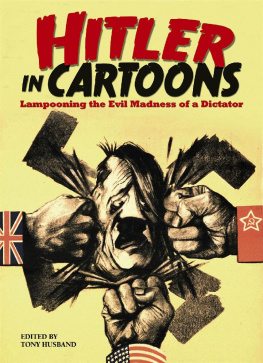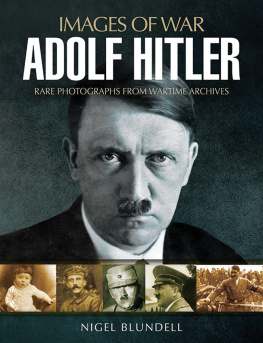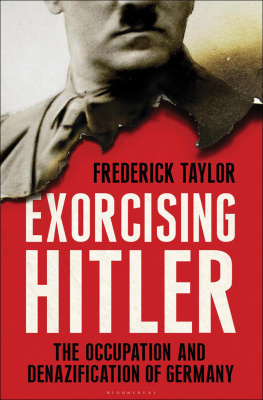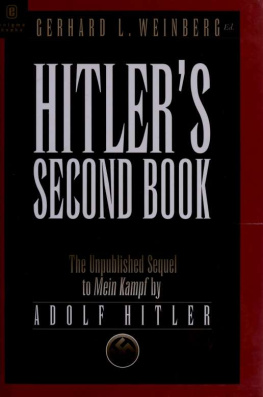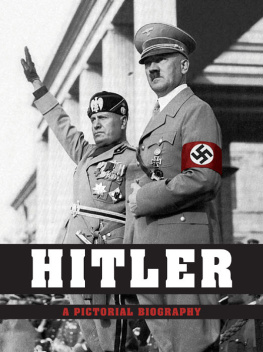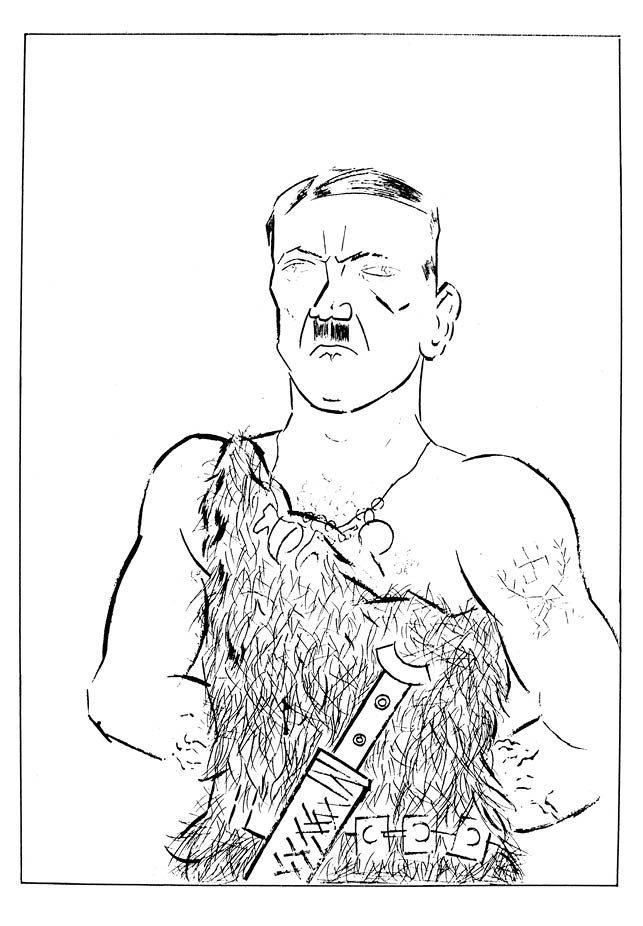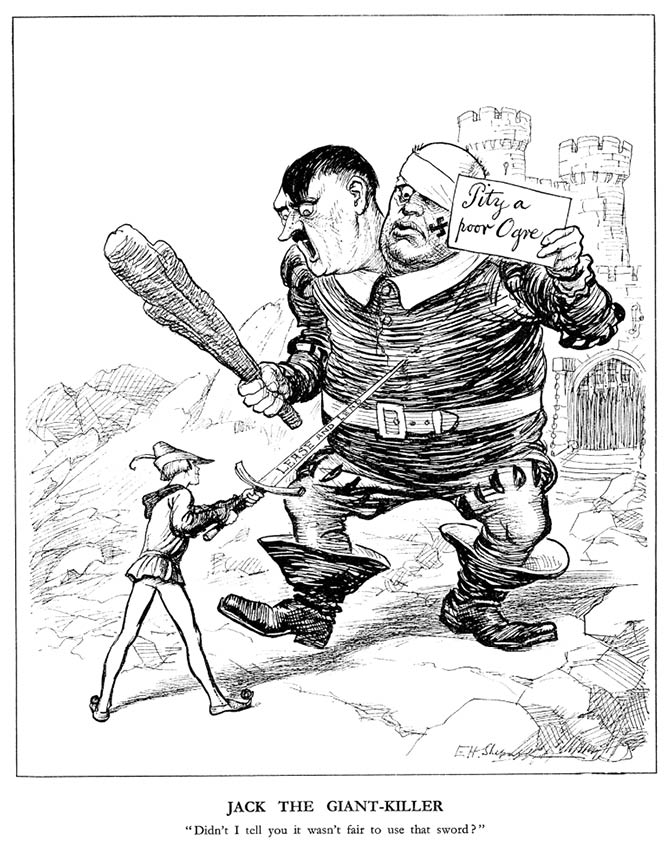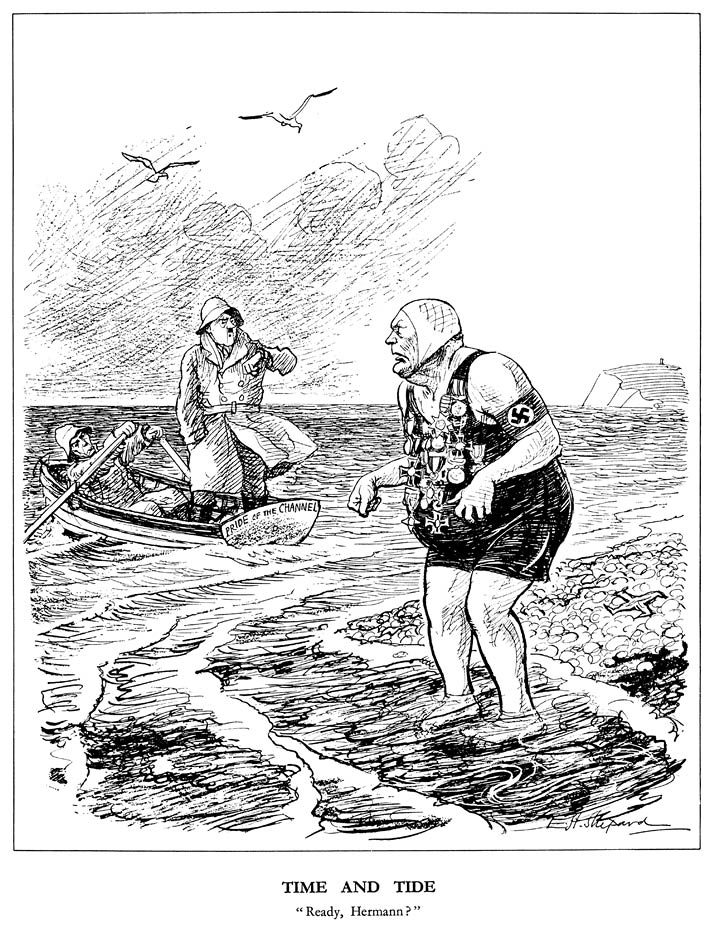Introduction
At the beginning of the 1920s, everyone seemed to underestimate Adolf Hitler. After all, no one could have foreseen the full horror of what he was about to inflict on the world. But when this awkward figure of a man stepped on stage and started ranting about the Vaterland , vast numbers of people proved only too willing to listen to what he was saying.
He became the Germans dark Messiah, the sick-minded visionary at the heart of the nation, driving it on to increasingly reckless acts of folly. Soon the Nazis were marching across Europe, committing unspeakable crimes in the name of the Third Reich.
Perhaps because he was a gift to draw, with his cows lick hairstyle and pencil mustache, cartoonists latched on to Hitler quicklymuch more quickly than the majority of politicians.
By the late 1930s, a significant number of European leaders were in favor of appeasing the Nazis. Some of them claimed Hitler had brought order and prosperity back to his country; but it is more likely that they were too afraid of Germanys growing military might to voice any oppostion to their dangerous neighbor.
Cartoonists are a skeptical lot. Theyre trained to look behind false rhetoric and seek out the inner personto home in on weaknesses and frailtiesand then, with a joke and a few skilful brushstrokes, reveal the truth behind the headlines.
At first, many cartoon images of Hitler and his acolytes were simply mocking, but the nature of the drawings darkened as the horrific reality of his regime emerged.
German cartoonists who had been depicting Hitler as deluded, depraved, or dim were doing a decent job of showing him up for what he was, but they fell silent as the power of the Nazis grew.
The reason was simple. After Hitler seized power in 1933, any publication that opposed him was shut down or co-opted to the Nazi cause. Many artists and writers were either imprisoned or forced into exile.
Some sought refuge in neighboring countries, only to have to flee for their lives as triumphant German forces crossed more and more borders, exporting Nazi dogma and intolerance as they did so.
Domestically, repression worsened as Germanys misfortunes grew, particularly in the wake of Stalingrad, and jokes against the regime were no longer tolerated.
In 1943, when someone snitched on Berlin munitions worker Marianne Elise Krchner for telling a joke about Hitler and Hermann Goering, she was guillotined for undermining the war effort, even though Hitler was well-known for telling jokes about members of his entourage, especially Goering (though not about himself!).
Similarly, it was not advisable to call one of your pets Adolf, as there were special courts available to try you if you did, and Nazi judges were not renowned for their sense of humor. Dictators and their hangers-on function best in a climate of fear. Humor is their Achilles heel, so anyone who mocks them does so at their peril.
Hitlers power depended on the idea that he was invincible, which is why he and his propagandists created the myth of a perfect being called the Fhrer , whose judgement could never be questioned. This was like a red rag to a bull for cartoonists, who mocked Hitlers grandiosity with visual depictions of a puffed-up, deluded tyrant.
At the same time, many Germans became true believers. They swallowed Nazi propaganda undiluted and the scales didnt fall from their eyes until Hitler and Eva Braun committed suicide in their Berlin bunker and the Red Flag was flying over the ruins of the Reichstag (the German parliament) in 1945.
It can be hard to understand how Hitler got away with it. Today, world leaders are under constant scrutiny on Facebook, Twitter, and other networking systemsevery stammer, twitch, and nuance is notedbut last century tyrants could literally get away with murder because the media had far fewer outlets and these could be controlled relatively easily. Hitler had ample opportunity to build up his Fhrer mystique.
But nothing eludes the gaze of cartoonists. They saw the madness in his eyes and they started ringing the alarm bells.
You can see great examples of what they came up with in these pages: Hitlers mouth as the barrel of a gun, talking peace, but built to spit out death; or Hitler actually in league with Death. Yet another image from 1933 shows him carrying a torch burning with racial hatred. Across the world, cartoonists lined up to hit Hitler where it hurt. And somehow its still satisfying to imagine him jumping up and down with rage at their drawings. To get them back, Hitler drew up a blacklist of cartoonistsnames of those to be dealt with when victory came.
In my minds eye, I picture Hitler conquering the world and immediately opening up a special prison for cartoonists. He might have had them mounted on plaques like Big Game trophies, pens in hand and with ink as their blood, but somehow, I think, theyd still have found a way of making him look a fool.
Like many famous people, Hitler collected cartoons about himself. In a vain attempt to protect his image, he employed press officers to go through the worlds newspapers and bring offending items to his attention. One day his Harvard-educated Press Secretary Ernst Titch Hanfstaengl came up with an idea that was to make him a fortune.
A book called Hitler in Cartoons of the WorldFacts versus Ink appeared in 1933. It featured a cartoon about Hitler on the left-hand page of each spread, with a Nazi rant on the other, rebutting the message of the drawing. But words cant beat pictures, so it all fell a bit flat. It was still a best-seller, though. Later Hanfstaengl fell out badly with Hitler and headed for the U.S. with his ill-gotten gains.
Still, its safe to conclude there was nothing Hitler hated more than being made a laughing stock by cartoonists. He had good reason. All the jokes about him and the Nazisday after day in paper after paper, like an endlessly dripping tapbuilt up until they played a big part in shaping U.S. public opinion, for example in persuading Americans to come in on the side of the Allies.
A legion of top cartoonists had toiled away ceaselessly until their image of Hitler was the one the world came to accept (and still does), and for that we should be truly grateful. Without their efforts, we might not enjoy the freedoms of today.
Tony Husband
Hitler the Saviour by George Grosz (1923): This drawing mocks a popular postcard of the time by photographer Heinrich Hoffmann, which featured Hitler in a trenchcoat. Alluding to the Grimms fairytale about a man in a bearskin who made a pact with the devil as well as Wagners Ring Cycle , Grosz concludes that Hitler is a throwback to another age. This portrait was included in the Nazis Degenerate Art Exhibition, 1937.
Jack the Giant-Killer by E. H. Shepard (1941): The Lend-Lease program, An Act to Promote the Defense of the United States, was the banner under which the U.S. supplied Free France, Britain, China, the U.S.S.R., and other Allied nations with oil, food, and weapons from 1941 to 1945. Effectively, it marked the end of neutrality for America, which shipped over $50 billion worth of supplies.
Time and Tide by E. H. Shepard (1941): Hitler waits impatiently for Hermann Goering in a boat called Pride of the Channel . By 1941 Goering had gone from national hero to zero in Germany after the failure of the Luftwaffe to soften up Britain for invasion. Now hes going to have to swim the Channel himself, which wont be easy with all those medals on his chest. Ready, Hermann? Hitler says.

